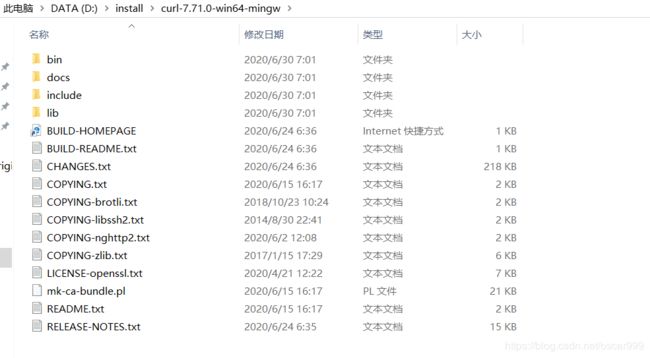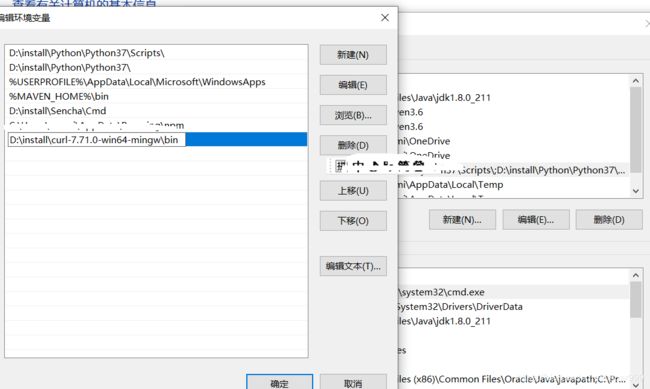windows下的安装与使用curl实现命令行访问Web网站
文章目录
- curl 是什么?
- curl 能干什么?
- Windows下的curl的使用
- curl常见用法
- 获取内容的命令选项
- 参数传递(-d)
- Cookie操作
- 使用注意事项
- curl 命令选项大全
curl 是什么?
矫情一点, curl应该写作cURL, 全写是:CommandLine Uniform Resource Locator, 命令行统一资源定位器。顾名思义,cURL就是使用命令行访问网页URL的工具。
Linux系统自带curl工具, 以CentOS为例, 在命令行终端输入:
curl https://www.baidu.com
curl 能干什么?
正常使用浏览器访问在线网页,是不需要使用curl的, curl比较常使用在爬虫程序或是网页分析的程序中。场景包括:
- 定期爬某些网站,获取源码,解析其中有用的部分
- 企业内部系统串接, 被访问系统提供HTTP(s)的对外接口,附加GET类型的参数,并返回执行成功与失败的响应。
- 脚本程序。比如批次脚本或是部署脚本。
Windows下的curl的使用
Windows默认没有提供该工具,但可以下载第三方的程序,下载地址:
https://curl.haxx.se/windows/
下载页面如下(根据操作系统版本选择下载):

下载完成是一个.zip 的压缩文件, 要在命令行窗口直接使用curl命令,需要做以下两件事:
- 下载之后解压。
- 配置环境变量。将curl解压后的bin目录配置到系统Path变量中,这样打开命令行就可以直接使用curl命令了。
这里解压到D盘install 目录,解压后目录结构如下:

Windows 10下环境配置页面如下:

以上配置完成,新开Windows 命令行窗口, 输入 curl https://www.baidu.com, 出现以上和Linux类同的响应即安装成功。
curl常见用法
除了获取页面源码外, curl 还可以通过添加命令选项获取头信息、添加参数、发送Cookie等操作。
获取内容的命令选项
- 基本使用,获取内容(HTTP源码)
curl www.baidu.com -i除了网页内容,还包括头信息,比如curl www.baidu.com -i
-I仅获取头信息,比如:curl www.baidu.com -I
-v获取更详细的信息, 比如:curl www.baidu.com -v。 v是verbose(详细)的简写, 包括:源码,头,IP,协议等
参数传递(-d)
curl使用 -d 选项传递参数,对于不同类型的请求参数,可以结合 -X 参数。
- GET类型的参数
GET类型的请求参数其实可以直接附加在URL后面, 类似:http://地址?参数名1=参数值1&参数名2=参数值2。也可以使用 -d 和 -G 选项(-d 后面是参数的键和值, -G代表GET方法类型,与-X GET 效果类似),类似:
curl -G -d "username=oscar" www.baidu.com
- POST方法参数
直接看实例:
curl -d "username=oscar" -X POST www.baidu.com
这里的 -X POST也可以省略,直接写成:
curl -d "username=oscar" www.baidu.com
- 多个参数的传递
多个参数可以使用 &, 也可以使用多个 -d。
方式1: 使用&
curl -d "username=oscar&password=123" www.baidu.com
方式2: 多个 -d 选项
curl -d "username=oscar" -d "password=123" www.baidu.com
- 参数文件
如果参数较多的话,也可以将参数放在一个文件中,使用参数文件进行传递,比如:
curl -d "@params.txt" www.baidu.com
params.txt是文件名
Cookie操作
Cookie的操作包括:
- 发送Cookie到服务端
- 接收服务端返回的Cookie,写入本地
对应以上两种操作,可以分别使用 -b 和 -c 命令选项。 -b, 发送Cookie到服务器 ,示例:curl -b "foo=bar" www.baidu.com, 也可以发送文件,示例:curl -b cookies.txt www.baidu.com-c,将Cookie写入文件,示例:curl -c cookies.txt www.baidu.com
使用注意事项
以上参数使用双引号包含起来的,类似 “username=oscar”,在Linux系统下也可以使用单引号。但是在Windows下使用单引号会无法成功执行,出现的状况是:命令执行后,页面卡住不动。
curl 命令选项大全
--anyauth Pick "any" authentication method (H)
-a, --append Append to target file when uploading (F/SFTP)
--basic Use HTTP Basic Authentication (H)
--cacert FILE CA certificate to verify peer against (SSL)
--capath DIR CA directory to verify peer against (SSL)
-E, --cert CERT[:PASSWD] Client certificate file and password (SSL)
--cert-type TYPE Certificate file type (DER/PEM/ENG) (SSL)
--ciphers LIST SSL ciphers to use (SSL)
--compressed Request compressed response (using deflate or gzip)
-K, --config FILE Specify which config file to read
--connect-timeout SECONDS Maximum time allowed for connection
-C, --continue-at OFFSET Resumed transfer offset
-b, --cookie STRING/FILE String or file to read cookies from (H)
-c, --cookie-jar FILE Write cookies to this file after operation (H)
--create-dirs Create necessary local directory hierarchy
--crlf Convert LF to CRLF in upload
--crlfile FILE Get a CRL list in PEM format from the given file
-d, --data DATA HTTP POST data (H)
--data-ascii DATA HTTP POST ASCII data (H)
--data-binary DATA HTTP POST binary data (H)
--data-urlencode DATA HTTP POST data url encoded (H)
--delegation STRING GSS-API delegation permission
--digest Use HTTP Digest Authentication (H)
--disable-eprt Inhibit using EPRT or LPRT (F)
--disable-epsv Inhibit using EPSV (F)
-D, --dump-header FILE Write the headers to this file
--egd-file FILE EGD socket path for random data (SSL)
--engine ENGINGE Crypto engine (SSL). "--engine list" for list
-f, --fail Fail silently (no output at all) on HTTP errors (H)
-F, --form CONTENT Specify HTTP multipart POST data (H)
--form-string STRING Specify HTTP multipart POST data (H)
--ftp-account DATA Account data string (F)
--ftp-alternative-to-user COMMAND String to replace "USER [name]" (F)
--ftp-create-dirs Create the remote dirs if not present (F)
--ftp-method [MULTICWD/NOCWD/SINGLECWD] Control CWD usage (F)
--ftp-pasv Use PASV/EPSV instead of PORT (F)
-P, --ftp-port ADR Use PORT with given address instead of PASV (F)
--ftp-skip-pasv-ip Skip the IP address for PASV (F)
--ftp-pret Send PRET before PASV (for drftpd) (F)
--ftp-ssl-ccc Send CCC after authenticating (F)
--ftp-ssl-ccc-mode ACTIVE/PASSIVE Set CCC mode (F)
--ftp-ssl-control Require SSL/TLS for ftp login, clear for transfer (F)
-G, --get Send the -d data with a HTTP GET (H)
-g, --globoff Disable URL sequences and ranges using {} and []
-H, --header LINE Custom header to pass to server (H)
-I, --head Show document info only
-h, --help This help text
--hostpubmd5 MD5 Hex encoded MD5 string of the host public key. (SSH)
-0, --http1.0 Use HTTP 1.0 (H)
--ignore-content-length Ignore the HTTP Content-Length header
-i, --include Include protocol headers in the output (H/F)
-k, --insecure Allow connections to SSL sites without certs (H)
--interface INTERFACE Specify network interface/address to use
-4, --ipv4 Resolve name to IPv4 address
-6, --ipv6 Resolve name to IPv6 address
-j, --junk-session-cookies Ignore session cookies read from file (H)
--keepalive-time SECONDS Interval between keepalive probes
--key KEY Private key file name (SSL/SSH)
--key-type TYPE Private key file type (DER/PEM/ENG) (SSL)
--krb LEVEL Enable Kerberos with specified security level (F)
--libcurl FILE Dump libcurl equivalent code of this command line
--limit-rate RATE Limit transfer speed to this rate
-l, --list-only List only names of an FTP directory (F)
--local-port RANGE Force use of these local port numbers
-L, --location Follow redirects (H)
--location-trusted like --location and send auth to other hosts (H)
-M, --manual Display the full manual
--mail-from FROM Mail from this address
--mail-rcpt TO Mail to this receiver(s)
--mail-auth AUTH Originator address of the original email
--max-filesize BYTES Maximum file size to download (H/F)
--max-redirs NUM Maximum number of redirects allowed (H)
-m, --max-time SECONDS Maximum time allowed for the transfer
--metalink Process given URLs as metalink XML file
--negotiate Use HTTP Negotiate Authentication (H)
-n, --netrc Must read .netrc for user name and password
--netrc-optional Use either .netrc or URL; overrides -n
--netrc-file FILE Set up the netrc filename to use
-N, --no-buffer Disable buffering of the output stream
--no-keepalive Disable keepalive use on the connection
--no-sessionid Disable SSL session-ID reusing (SSL)
--noproxy List of hosts which do not use proxy
--ntlm Use HTTP NTLM authentication (H)
-o, --output FILE Write output to <file> instead of stdout
--pass PASS Pass phrase for the private key (SSL/SSH)
--post301 Do not switch to GET after following a 301 redirect (H)
--post302 Do not switch to GET after following a 302 redirect (H)
--post303 Do not switch to GET after following a 303 redirect (H)
-#, --progress-bar Display transfer progress as a progress bar
--proto PROTOCOLS Enable/disable specified protocols
--proto-redir PROTOCOLS Enable/disable specified protocols on redirect
-x, --proxy [PROTOCOL://]HOST[:PORT] Use proxy on given port
--proxy-anyauth Pick "any" proxy authentication method (H)
--proxy-basic Use Basic authentication on the proxy (H)
--proxy-digest Use Digest authentication on the proxy (H)
--proxy-negotiate Use Negotiate authentication on the proxy (H)
--proxy-ntlm Use NTLM authentication on the proxy (H)
-U, --proxy-user USER[:PASSWORD] Proxy user and password
--proxy1.0 HOST[:PORT] Use HTTP/1.0 proxy on given port
-p, --proxytunnel Operate through a HTTP proxy tunnel (using CONNECT)
--pubkey KEY Public key file name (SSH)
-Q, --quote CMD Send command(s) to server before transfer (F/SFTP)
--random-file FILE File for reading random data from (SSL)
-r, --range RANGE Retrieve only the bytes within a range
--raw Do HTTP "raw", without any transfer decoding (H)
-e, --referer Referer URL (H)
-J, --remote-header-name Use the header-provided filename (H)
-O, --remote-name Write output to a file named as the remote file
--remote-name-all Use the remote file name for all URLs
-R, --remote-time Set the remote file's time on the local output
-X, --request COMMAND Specify request command to use
--resolve HOST:PORT:ADDRESS Force resolve of HOST:PORT to ADDRESS
--retry NUM Retry request NUM times if transient problems occur
--retry-delay SECONDS When retrying, wait this many seconds between each
--retry-max-time SECONDS Retry only within this period
-S, --show-error Show error. With -s, make curl show errors when they occur
-s, --silent Silent mode. Don't output anything
--socks4 HOST[:PORT] SOCKS4 proxy on given host + port
--socks4a HOST[:PORT] SOCKS4a proxy on given host + port
--socks5 HOST[:PORT] SOCKS5 proxy on given host + port
--socks5-basic Enable username/password auth for SOCKS5 proxies
--socks5-gssapi Enable GSS-API auth for SOCKS5 proxies
--socks5-hostname HOST[:PORT] SOCKS5 proxy, pass host name to proxy
--socks5-gssapi-service NAME SOCKS5 proxy service name for gssapi
--socks5-gssapi-nec Compatibility with NEC SOCKS5 server
-Y, --speed-limit RATE Stop transfers below speed-limit for 'speed-time' secs
-y, --speed-time SECONDS Time for trig speed-limit abort. Defaults to 30
--ssl Try SSL/TLS (FTP, IMAP, POP3, SMTP)
--ssl-reqd Require SSL/TLS (FTP, IMAP, POP3, SMTP)
-2, --sslv2 Use SSLv2 (SSL)
-3, --sslv3 Use SSLv3 (SSL)
--ssl-allow-beast Allow security flaw to improve interop (SSL)
--stderr FILE Where to redirect stderr. - means stdout
--tcp-nodelay Use the TCP_NODELAY option
-t, --telnet-option OPT=VAL Set telnet option
--tftp-blksize VALUE Set TFTP BLKSIZE option (must be >512)
-z, --time-cond TIME Transfer based on a time condition
-1, --tlsv1 Use => TLSv1 (SSL)
--tlsv1.0 Use TLSv1.0 (SSL)
--tlsv1.1 Use TLSv1.1 (SSL)
--tlsv1.2 Use TLSv1.2 (SSL)
--trace FILE Write a debug trace to the given file
--trace-ascii FILE Like --trace but without the hex output
--trace-time Add time stamps to trace/verbose output
--tr-encoding Request compressed transfer encoding (H)
-T, --upload-file FILE Transfer FILE to destination
--url URL URL to work with
-B, --use-ascii Use ASCII/text transfer
-u, --user USER[:PASSWORD] Server user and password
--tlsuser USER TLS username
--tlspassword STRING TLS password
--tlsauthtype STRING TLS authentication type (default SRP)
--unix-socket FILE Connect through this UNIX domain socket
-A, --user-agent STRING User-Agent to send to server (H)
-v, --verbose Make the operation more talkative
-V, --version Show version number and quit
-w, --write-out FORMAT What to output after completion
--xattr Store metadata in extended file attributes
-q If used as the first parameter disables .curlrc
